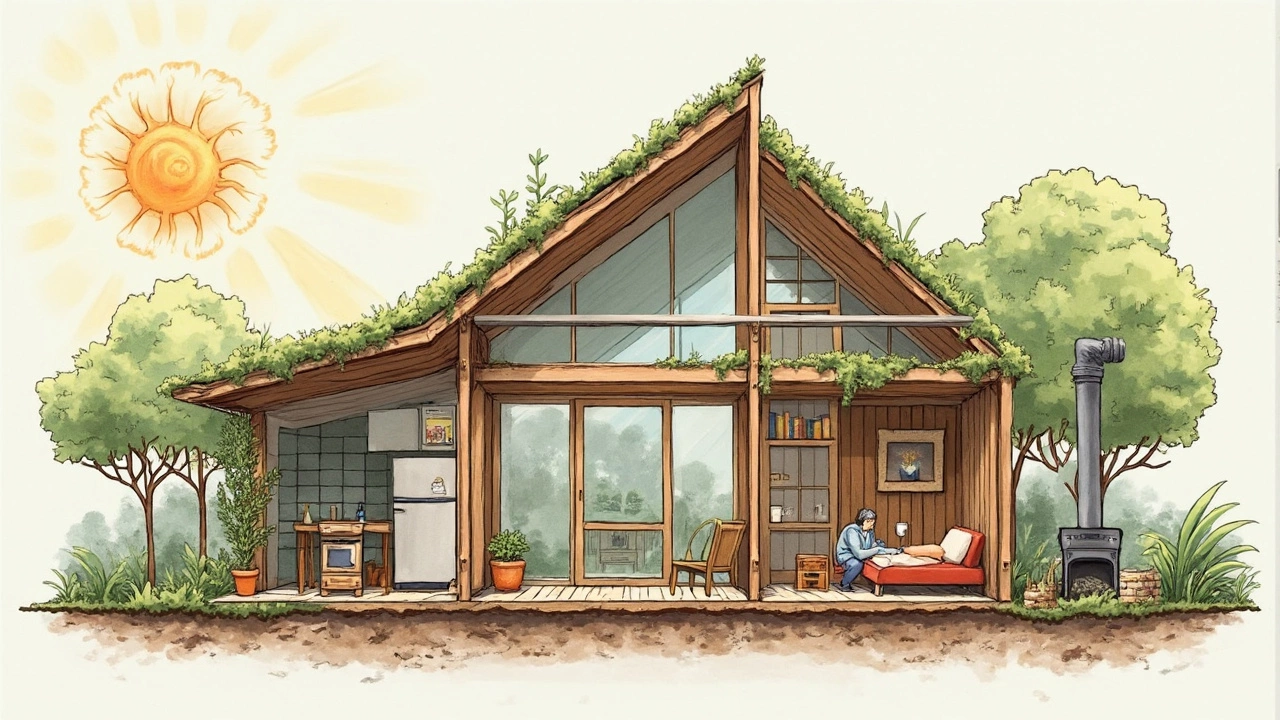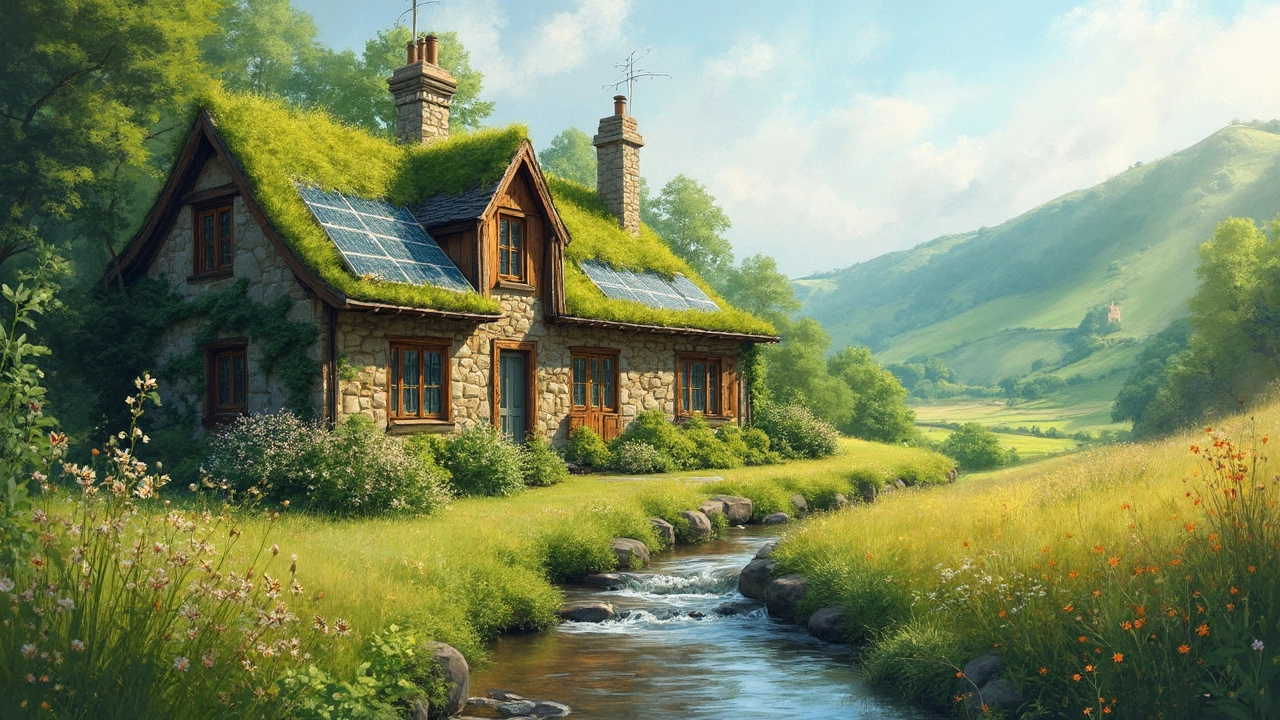So, you've heard about eco cottages, right? These little marvels of sustainability are gaining attention for all the right reasons. But what makes them so special? Let's break it down.
Eco cottages are all about reducing your footprint while keeping comfort in check. They're designed with a keen focus on doing more with less—less energy, less water, and, you guessed it, less impact on our lovely planet. These homes aren't just structures; they're statements about living gently on Earth.
From solar panels to recycled materials, their features are a breath of fresh air compared to conventional homes. Imagine a place that naturally cools in summer and stays snug in winter, using clever design and natural resources. Sounds pretty appealing, doesn't it?
Stick around as we explore what defines an eco cottage, the standout features that make them unique, and why jumping on board the eco-living train is worth considering. Plus, if you're thinking of building your own, I've got a few handy tips to share.
- Defining Eco Cottages
- Key Features of Eco Cottages
- Benefits of Living in an Eco Cottage
- Tips for Building Your Own Eco Cottage
Defining Eco Cottages
Alright, let's get into what an eco cottage really is. Picture a cozy home, but it's doing a stellar job respecting Mother Nature. At its core, an eco cottage is a house that's crafted with the environment in mind, embracing sustainability at every step.
These cottages merge traditional building smarts with modern green technology. They lean heavily on sustainable materials—think bamboo, recycled steel, and reclaimed wood. Using materials that don't harm our planet plays a crucial part in their charm.
Energy Efficiency
One of the defining features of eco-friendly cottages is their impressive energy efficiency. Many come equipped with solar panels or wind energy systems, allowing folks to reduce reliance on non-renewable energy sources. By optimizing every square inch, they keep utility bills low and spirits high.
Water Conservation
Eco cottages often include systems that save water, such as rainwater collection systems or efficient plumbing fixtures. It's all about tapping into natural resources without going overboard. Letting you enjoy those long showers without the guilt trip!
Smart Design
The design of an eco cottage is clever, using natural light and thermal mass to regulate temperature. Open layouts often favor natural airflow, meaning air conditioning is a backup player rather than a headliner. It’s smart, simple, and pretty cool (literally).
| Feature | Impact |
|---|---|
| Sustainable Materials | Reduces environmental impact |
| Solar Panels | Decreases energy bills |
| Efficient Water Systems | Lowers water usage |
The beauty of an eco cottage is how it invites you to be part of the ecosystem, not a visitor who leaves a mess. They’re not just homes; they’re a nod to living in harmony with our environment.
Key Features of Eco Cottages
What sets eco-friendly cottages apart from your standard home? It's all in the mix of innovative materials, energy-saving tech, and sustainable design principles. Let’s dig into some must-know features that make these homes truly green.
1. Energy Efficiency
One of the stellar aspects of eco cottages is their incredible energy efficiency. They often come equipped with solar panels or other renewable energy sources that drastically cut down electricity use. Many also use triple-glazed windows and superior insulation materials to keep temperatures just right without over-relying on heaters or ACs. You might say they're like thermos flasks for people!
2. Sustainable Materials
These homes are built using materials that are as kind to the planet as possible. Think bamboo flooring, reclaimed wood for beams, and recycled metal for roofing. These materials not only look great but also lessen the environmental impact.
3. Water Conservation
Eco cottages take water use very seriously. Many are fitted with rainwater harvesting systems, grey water recycling, and low-flow fixtures to cut down on water waste. You'd be surprised how much water a household can save with just a few tweaks!
4. Smart Design
Simplicity and functionality reign supreme in an eco cottage’s design. Architects often utilize natural lighting and passive solar heating; basically, these homes are positioned and designed to take full advantage of the sun's path and breeze flows. By being clever about layout, eco cottages reduce dependency on artificial lighting and climate control.
Interesting Fact
Did you know that living in an eco cottage can reduce your utility bills by up to 50%? A table at a recent green building conference highlighted these savings, underscoring the financial benefits of going green.
Embracing these eco-friendly cottages is more than just a trend; it's about sustainable living that respects nature while keeping you snug as a bug at home.

Benefits of Living in an Eco Cottage
Living in an eco-friendly cottage offers loads of perks that go beyond just being kind to the environment. It’s a lifestyle choice that brings tangible benefits for you and your family.
Cost Savings on Utilities
One of the biggest draws is the long-term cost savings. Thanks to energy-efficient systems like solar panels and rainwater collection, your utility bills could see a significant decrease. Imagine heating your home with the sun's energy instead of relying on expensive grid electricity. Who wouldn’t love lower monthly costs?
Healthy Living Environment
These eco cottages often use natural and non-toxic materials. This means you’re reducing your exposure to potentially harmful chemicals found in conventional building materials. Cleaner air and a natural setting can contribute to a healthier home life.
Environmental Impact
By reducing energy use and utilizing sustainable materials, eco cottages are kinder to our planet. They minimize greenhouse gas emissions and help conserve natural resources. Living in a green home means you’re making a real difference every day!
Resale Value
The demand for sustainable living options is on the rise. If you ever decide to sell, an eco cottage can offer a higher resale value thanks to its energy efficiency and modern, forward-thinking design.
Community and Connection
Many people are drawn to eco cottage communities that prioritize sustainability and green living. You’ll find a sense of community with like-minded neighbors, all working towards the shared goal of green homes.
Eco cottages are more than a trend; they’re a practical and impactful way to live in harmony with nature. Whether you're hooked by the cost savings, health benefits, or the bigger environmental picture, there’s plenty to appreciate about these unique homes.
Tips for Building Your Own Eco Cottage
So you're ready to join the sustainable living movement and create your own eco-friendly cottage? That’s fantastic! Let's break down some practical steps and considerations you’ll want to keep in mind.
Think About Location
The first step is all about location, location, location! Choose a spot with plenty of natural sunlight to maximize the use of solar panels. Consider the natural terrain too: does it lend itself to harnessing wind energy, or perhaps rainwater collection?
Start With Sustainable Materials
When it comes to building materials, go green! Look for recycled, reclaimed, or sustainably sourced wood. Concrete made with fly ash is another solid option. Don't forget about more unusual choices, like straw bale insulation or hempcrete, which add green credentials to your home.
Design for Energy Efficiency
A key part of your strategy should focus on making the home energy-efficient. Orienting windows to capture sunlight in winter while offering shade in summer is a clever design move. Opt for high-performance windows that help with insulation.
- Install solar panels to generate clean electricity.
- Consider geothermal heating systems for a clean, reliable heat source.
- Don’t skip on proper insulation—it’ll save energy by keeping the temperature stable.
Water Conservation
Next up: water conservation. Install low-flow fittings and fixtures to save water. Think about integrating a rainwater harvesting system. It's a smart way to keep your garden green and reduce reliance on supplied water.
Consider Smart Tech
Add some smart technologies to your cottage to manage energy use efficiently. Smart thermostats, energy-efficient appliances, and automated lighting systems can help reduce energy consumption without sacrificing comfort.
Planning and Permissions
Finally, check the zoning laws and building codes in your area. Eco-friendly designs might be new territory for local authorities, so be ready to share the benefits and get the necessary permits. A bit of groundwork here can save future headaches.
Example of Estimated Costs
Planning your budget? Here’s a rough estimate for some green tech options:
| Feature | Estimated Cost |
|---|---|
| Solar Panel System | $10,000 - $20,000 |
| Geothermal Heating | $15,000 - $30,000 |
| High-efficiency Windows | $5,000 - $10,000 |
Building an eco cottage isn’t just about ticking boxes; it’s about creating a haven that’s kind to the environment and a joy to live in. With these tips, you’re well on your way to an exciting and rewarding project!
